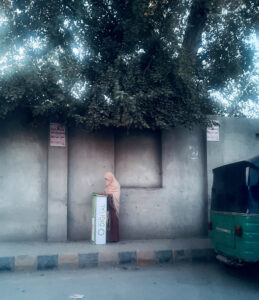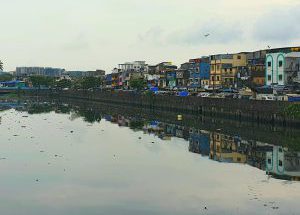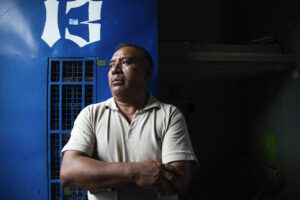
COVID-19 and spatial inequality: “Address discrimination” and biases worsen segregation for Mumbai’s slum residents

Sixty per cent of Mumbai’s 14 million inhabitants live in slums. They are no strangers to unequal access to water and sanitation, but the pandemic has shrunk their opportunities to find work and wages amid new forms of dispossession.

Two cities have lived in Mumbai for centuries, a city inside a fort for the colonists and another outside where the natives lived. These coexisting, codependent towns were there when the first modern docks of Bombay replaced traditional fishing harbors to give colonial business interests a flourishing seaport. These two disparate sides were still there when, decades later, historians gave Bombay the tag of urbs prima in Indis (the first city in India). Writing a foreword in 1876 to the second edition of his Guide To Bombay, British journalist James Mackenzie Maclean said he was adding, among other revisions, a schedule for outbound steamer ships from the city’s port after a friendly critic had pointed out a central failing in the first edition — visitors to Bombay were chiefly interested in how to get out. Two decades later, the bubonic plague arrived in Bombay on board merchant ships from further east. The worst affected areas were not in what used to be the walled city within Fort George; the brunt of the disease was borne by the city’s migrant workers, living in congested and unsanitary conditions around the cotton mills and marketplaces.
One outcome of the plague and the consequent exodus of Bombay’s working class was the formation of the Bombay City Improvement Trust (BIT) in 1898 by the colonial rulers. The government agency was tasked with conceiving a new spatial reality to make Bombay more habitable for workers, who were key to the city’s good fortunes. This development resulted in the eventual construction of the several BIT chawl buildings, complexes of oppressively small flats that are still home to tens of thousands in Mumbai. The chawls are a typology of working-class homes; they are three- or four-story apartment buildings with 10 to 20 single-room homes along long corridors, with shared toilet blocks usually located at the end of every corridor.
Then 1918 rolled around, bringing with it the Spanish flu. The BIT’s development work for healthier living spaces for the poor gathered pace and, early in the 1920s, the Trust tabled new plans for the growing city. Among other things, they proposed to convert Dharavi – then little more than a huddle of tanneries on a marsh – into a suburb. The annual administration reports of the Trust reflect these plans. Exactly a hundred years later, an ambitious plan drawn up in 2004 to raze and redevelop Dharavi – Asia’s largest shanty-town where 850,000 to a million people live in just about one square mile – remains a non-starter.
And during the century that has passed since a government agency was set up with the express purpose of improving living standards for residents, the boundaries of the two cities that constitute Bombay, now Mumbai, have hardened.
*
Asymmetries in access to municipal or government services including healthcare have always been noticeable in Mumbai’s slum neighborhoods, where 60 per cent of Mumbai’s 14 million residents live. But since March 2020, when the Government of India imposed a nationwide lockdown to tackle the spread of COVID-19, the boundaries of these poorly serviced pockets have sharpened.
According to the Centre for Monitoring Indian Economy (CMIE), the number of employed Indians shrunk by 121.5 million in April, a bloodbath of job losses. Of these, 91.2 million – about three quarters – were informal sector workers including daily wage laborers in construction and other industries, small traders and hawkers. “This category of employment accounted for about 32 per cent of the total employment but it suffered 75 per cent of the hit in April. Large numbers of these people lost their source of livelihood so quickly because their employment is almost entirely informal,” the CMIE report said. In Mumbai, India’s financial capital where informal workers can rarely afford housing other than in informal settlements, the April job carnage translated into a sudden, overnight destitution for the majority of slum residents.
According to the International Labor Organization, employment in India’s construction industry doubled between 2004-05 and 2011-12, and continued to grow subsequently, a central factor in absorbing agriculture’s surplus labor migrating into big cities. Arguably the biggest employer of Mumbai’s slum residents, the building and construction industry halted as the lockdown began, rendering millions jobless. As construction work, industries, offices, malls and transport systems wound down, the large majority of Mumbai’s slumdwellers lost work including street-vendors, domestic workers, small traders, and the self-employed plumbers, electricians, carpenters, artisans, mechanics.
More than five months later, as India’s lockdown is lifted in phases, informal sector jobs are indeed reviving. But in Mumbai’s slums, tens of thousands continue to be without work, their residential addresses frequently limiting their access to livelihood.
A prominent example are the domestic workers employed by households as cleaning or cooking staff. Months into the lockdown, most employers are wary of permitting staff with slum addresses back into apartments. Only about 100,000 domestic help are registered with the state government, though this mostly female army is about 700,000-strong. These women were summarily dismissed, or received no pay or only partial payments through the April-August 2020 period. Those who returned to work by September found they have much less work than earlier, as households cut back on the number of staff and on payments. A survey of more than 5,000 domestic workers by two unions found 24 per cent reporting complete job loss, and 62 per cent reporting partial job loss.
“At one point the government indicated it would make a one-time payment to us as assistance, but nothing materialized. In fact, the state government refused to step in when the managing committees of these apartment complexes refused to allow us to enter,” Surekha Jadhav told me. Surekha, in her early forties, is one of dozens of women in the Kapaswadi slum, located in a western suburb, who are employed as domestic help or cooking staff in apartments. A single mother, Surekha told me she worked in four households until the lockdown. With none of her employers willing to pay wages for the lockdown period, she has had to accept groceries from a charitable group. Her daughters, both teenagers and students at a private school, faced the embarrassment of a WhatsApp group chat in which a teacher told them they would be removed from the group unless their school dues were paid. With classes completely online for now, the class WhatsApp group is the chief medium of communication.
In the Ambujwadi slum in north-west Mumbai, Poonam Goud’s mother, a cancer survivor and a domestic help, found her income down to zero even as Poonam, barely 20 years old, told me she had borrowed heavily to pay for medical care.
Across Mumbai, through July and August 2020, I saw small gaggles of women at the gates of apartment complexes, requesting guards to allow them in so they could meet their former employers, request to be hired back, ask for back wages or at least for advance payments. On 26 June, the state government issued an order clarifying that domestic workers were not prohibited from entering apartment complexes. The order was responding to several news reportson managing committees of apartments disallowing these services during the lockdown. The government order said the services of such household staff had never been curtailed, and apartment managers must not make decisions contrary to government rules. Having stated the rule, however, the government did nothing to enforce it — most apartment-dwellers were wary of staff from slum colonies that were generally viewed as COVID-hotspots.
From April through July 2020, in India’s most cosmopolitan and egalitarian city, the slums became the site of an informal apartheid, a non-institutionalized segregation that most people outside these spaces willingly abided by.
Mumbai’s inequalities are visually stark. Luxury apartments that command among the world’s highest real estate prices stand cheek-by-jowl with colonies of informal homes that have tin roofs covered with tarpaulin sheets. Unlike many global megacities, Mumbai’s poor don’t live hidden out of sight. The slums dot the entire expanse of the city’s geography, putting their residents within walking distance of train stations, markets, construction sites, apartment buildings, commercial hubs, malls and more. This spatial pattern is at the heart of cheap labor availability anywhere in Mumbai and its interdependent infrastructure.
However, as much as informal housing makes Mumbai tick, the proximity of the poor and of their densely populated living quarters has evoked fear and distrust since the imposition of the lockdown. When space and distance are the key elements of an epidemiological arsenal, the proximity of fellow Mumbaikars who live in overcrowded, poorly ventilated homes and share community toilets was seen as a health hazard.
In September, informal jobs in factories and construction sites have started picking up slowly, but many job-seeking slumdwellers experience the same spatial disadvantage that domestic workers speak of. These include people seeking work as helpers, shop assistants, watchmen, security personnel, drivers, who are often still seen as unemployable on account of their address. “If people say they’re from Dharavi, chances are they won’t get hired,” Atmadevi Jaiswar, a community worker for nearly two decades in Dharavi, told me. She introduced me to a group of men unable to find work. They included a man formerly employed as a guard and an entrepreneur-tailor who is now unable to find customers.
Dharavi is iconic for its industry, not its grime. Thousands of sweatshops, recyclers, leather goods manufacturers and food products manufacturers located within this once-bustling slum are still closed — some localities are still to get permissions to restart normal activities, and the majority of the 500,000 migrant workers who fled the slum is also yet to return. Other Mumbai slums, to varying extents, are also home to sweatshops and home-industry that has now come to a halt. The workers left amid an exodus from Mumbai’s slums in April and May: their forced reverse migration another facet of their segregation.
*
What is home, if you must flee it to survive? The exodus from Mumbai’s slums picked up pace in the first half of May 2020, tying in precisely with the CMIE’s assessment that the month of April was devastating for India’s informal workers. With no wages and no social capital or significant assets in Mumbai, tens of thousands of Mumbai’s slumdwellers fell back on family networks in native villages to see them through the lockdown. By mid-May, a hush had fallen over once-clamorous alleys and bylanes as unofficial estimates pegged the number of slumdwellers who had left India’s financial capital at 700,000 to 800,000. That number grew through May and, by the time the first pre-monsoon showers arrived in June, about 20 per cent of the city’s slums were empty, the percentage higher in industrial parts of slums, such as Dharavi’s 13th Compound, a hub of chemical and recycling units.
A shocked silence fell across the slums, in the rented living spaces where 10 to 20 workers would sleep in shifts, in the former community meal spaces operated by residents, the public toilets and the community water standposts where residents would queue up.
Slumdwellers left in droves, finding safety in numbers and accompanying others coming from the same native district or state. Autorickshaw-drivers from the slums piled their families and belongings into their three-wheeler vehicles and drove hundreds of kilometers. Thousands walked, children in tow. They faced baton-wielding policemen forcing them back, trying to enforce the shelter-in-place rules.
ActionAid (India) compiled a report based on the findings of a pan-India survey of informal workers conducted during the end of May 2020. The report found that the loss of housing was a major issue precipitating the decision of migrant workers to return to their native towns and villages. “In the sample, almost 60 percent of migrants said that they had to vacate their housing after the lockdown. There was also an alarming increase in the level of food insecurity, and a decline in water consumption to a lesser extent. This was partly due to restrictions on movement but is largely indicative of the lack of food reserves in poor households, their inability to save and stock up, and their low levels of enrolment and access to welfare schemes such as the Public Distribution System (PDS).”
The migrant workers, many of them residents of slums, were so vulnerable that they could not afford Mumbai’s cheapest housing unless work and wages were available regularly. To varying extents, several slums have mixed-use units. Factory spaces may double up as dormitory rooms at night, or a home may turn into a tailoring unit after mid-day. Their mixed-use nature lends an additional affordability to these homes, and the low rents-shared rents-proximity to work equation is central to residents’ precarious existence: if one element is missing, the balance is lost. The pandemic wrenched this fine equilibrium, shutting down slum industries, making slum addresses fearsome, rendering more jobless, and finally leaving many homeless.
Slum residents’ susceptibility to being left out of government schemes is also partly on account of their address. To access the PDS scheme for free or subsidized foodgrain, beneficiaries are required to provide multiple documents including a stable proof of residence, which many find challenging even after decades of working in Mumbai. Slumdwellers’ jobs are predominantly informal and attrition rates high, forcing them to relocate periodically to move closer to their place of work. “Many have moved around frequently from one part of Mumbai to another, some are evicted and displaced as slum demolition is carried out, so they lack a stable address that is required by law to obtain a ration card that entitles them to benefits under the Food Security Act,” activist Mukta Srivastava told me. Srivastava is Maharashtra’s convener of the Right To Food Campaign, a civil society collective. “Also, many slumdwellers may have families back home in their villages and may be registered as beneficiaries at that location. For this and for other reasons, we have been demanding that the PDS be universalized so that the poor, wherever they are, can avail free foodgrain as per the law.”
The ActionAid report made similar recommendations — more inclusive spatial dimensions of livelihood and access to amenities in the post-pandemic revival. It called for improved living conditions for informal workers, especially in urban areas, through social housing and workers’ hostels, as well as meaningful social security and affordable public education and healthcare in their urban settlements.
Meanwhile, as those without the means to survive in their villages returned to Mumbai in August and September, newer disparities emerged. When Asif Shaikh, a 34-year-old from Giridih in the state of Jharkhand, returned to Mumbai in early August, he left his family behind for the first time ever, unsure if the children will return to school this year and hoping to send some money home by the end of September. A tailor at a sweatshop in south-central Mumbai, Asif told me: “Rent in Mumbai for a family, even in a slum, is more expensive than sleeping on the factory floor. Work is available two days a week, I spend the remaining days trying to find more work.” This cleaving of families further means that small retailers such as grocers and clothing stores inside or just outside the slums continue to find much of their market destroyed, with no sign of revival for many months to come.
*
Visible and prominent as the city’s slums are, its residents’ struggles have been invisibilized over the years. Already in 2005, the UN’s Report on the World Social Situation enunciated the “inequality predicament” and drew attention to the widening chasm between the formal and informal economies, warning that growing inequality could jeopardize the world’s chances of meeting internationally agreed upon development goals. In Indian cities too, the very visible post-globalization gains did not take everybody along. Fifteen years after the release of the report, Mumbai’s slumdwellers faced COVID-19 with the realization that the most basic and central recommendations issued by the government to avoid infection were beyond their means — hand-washing and social distancing.
In December 2014, the Bombay High Court defined the right to water an integral part of the Right to Life guaranteed by Article 21 of the Constitution of India. The Paani Haq Samiti (Right to Water Panel), a group of activists, organizations, institutions and slumdwellers, had filed a Public Interest Litigation in 2012 demanding that water supply be made available to all residents of Mumbai, including those residing in slums. “The right to life guaranteed by Article 21 is not of animal existence, but it is a right to live with human dignity,” the Court observed. “Such a citizen who occupies an illegal hut, has no right to retain the illegally constructed hut, but he cannot be deprived of his fundamental right to food and water which is an integral part of the right to life guaranteed under Article 21 on the ground that he is in occupation of an illegally constructed hut.” The Court ordered the municipality to develop a policy to supply water to these pockets within the city, even if it meant charging them a higher rate than the prevailing water tariff. More than five years after this order, as the first COVID-19 cases were recorded in Mumbai, Sitaram Shelar of Paani Haq Samiti wrote to Maharashtra Chief Minister Uddhav Thackeray and the then municipal commissioner Praveen Pardeshi asking for at least temporary water supply arrangements for Mumbai’s informal settlements.
“Since 2017, Paani Haq Samiti has filed applications seeking water connections for 8,000 families. Of these, only a little over 400 actually received connections. The remaining have been stalled for one reason or another, sometimes [because of] politics and corruption,” Shelar told me. Large numbers of slums in Mumbai have no water supply lines at all, some have a couple of community taps for thousands of residents, while others rely on stolen water from passing municipal lines. In the sprawling Ambujwadi slum along the north-western edge of the city, most of the nearly 100,000 residents pay about 30 Rupees daily for three jerry cans of water; more water is usually unavailable even to those willing to pay more. The rate to purchase water from informal sources is similar across slums. The jerry cans have an approximate capacity of 35 liters each, which works out to about 300 rupees for 1,000 liters of water for slumdwellers. In contrast, the Mumbai municipality provides water supply to apartment complexes at 5.22 rupees per 1,000 liters, a tariff that is among the lowest in the world.
In the shanty colonies, social distancing has been as challenging as hand-washing. Locking down Mumbai’s nearly 7 million slumdwellers proved to be counter-productive — not only must they step out and congregate to fetch water or use a public toilet, but the long hours that residents spend sequestered in cramped and poorly ventilated spaces have also made these localities more vulnerable to risk of infection. At the end of July, a serological survey showed that 57 per cent of surveyed slumdwellers had been exposed to the virus.

Spatial inequalities in accessing municipal services including sanitation, garbage collection, healthcare, fire-safety, flood-proofing were always identifiable in Mumbai. The physical nature of living spaces in slums brought unique challenges – such as the risk of mud slips and bounder crashes for residents of homes built on hillocks, or annual inundation in the rainy months for slums along the coast. Despite all these apparent exclusions and indignities, the city’s invitation to the dreamer and the desperate alike had an air of being unremitting, ceaseless. That veneer melted away steadily between April and August 2020.
Late in August, a union leader of contractual sanitation staff employed by the municipal corporation to load garbage into trucks said that about 350 safai kaamgar (sanitation workers) in the suburb of Andheri were facing discrimination and were being denied access to water and sanitation. Sanitation work in India predominantly employs the lower castes, who have worked through the pandemic despite the inadequate pay, absent training and often poor protective gear. Of the more than 100 municipal staff who died of COVID-19 in Mumbai, nearly one third were sanitation department staffers, including contractual workers, almost all slum-dwellers. The workers who allegedly were refused access to a toilet in Andheri were all Dalits or belonging to the Scheduled Castes; they also complained that they were being paid less than minimum wage.
The municipality said later that the complaint was only a misunderstanding. The middle classes who refuse to let maids and other staffers living in slums enter their gated communities explain away the exclusionist behavior as dictated by health concerns. Experts are still studying whether disaggregated recommendations for public health policy must be made based on spatial patterns of the COVID-19 infection. Meanwhile, in India’s financial capital, once acknowledged by colonists as the greatest city in India, the idea of inclusivity corrodes, as social distancing metastasizes into exclusion and spatial segregation.





